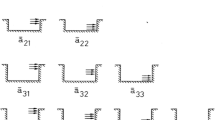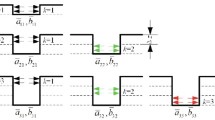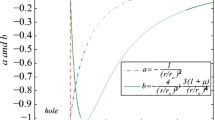Abstract
Background
There is a large geometrical variation among the commercially available strain gauge rosettes used for hole-drilling residual stress measurements. Detailed calibration data are readily available only for the rosette types described in ASTM Standard Test Procedure E837-20. This makes it difficult for the ordinary practitioner to use other rosette types for hole-drilling residual stress measurements.
Objective
The aim here is to develop a numerical adjustment scheme that can accommodate variations in strain gauge length and width, and enable the publicly available calibration data provided in E837-20 to be used with general rosette types.
Results
The proposed numerical adjustment scheme gives calibration results typically within ~ 2% of the values found from a custom computation based on the fine details of the strain gauge geometry. This effect may cause ~ 3% variations in the computed residual stresses.
Conclusions
The computed calibration data are suitable for practical hole-drilling measurements. The differences in the calibration data from the custom results are small compared with the range of the stress measurement errors typically encountered in practical hole-drilling.







Similar content being viewed by others
References
Schajer GS, Whitehead PS (2018) Hole-Drilling Method for Measuring Residual Stress. Morgan & Claypool, Williston, VT, USA
Grant PV, Lord JD, Whitehead PS (2002) The Measurement of Residual Stresses by the Incremental Hole Drilling Technique. Measurement Good Practice Guide No.53, National Physical Laboratory, Teddington, UK
Vishay Measurements Group, Inc. (1993) Measurement of Residual Stresses by the Hole-Drilling Strain-Gage Method. Tech Note TN-503–6. Vishay Measurements Group, Inc., Raleigh, NC. 16pp
Soete W, Vancrombrugge R (1950) An Industrial Method for the Determination of Residual Stresses. Proceedings SESA 8(1):17–28
Boiten RG, ten Cate W (1952) A Routine Method for the Measurement of Residual Stresses in Plates. Appl Sci Res A3(5):317–343
Kelsey RA (1956) Measuring Non-Uniform Residual Stresses by the Hole Drilling Method. Proceedings SESA 14(1):181–194
Rendler NJ, Vigness I (1966) Hole-drilling Strain-gage Method of Measuring Residual Stresses. Exp Mech 6(12):577–586
ASTM (2020) Determining Residual Stresses by the Hole-Drilling Strain-Gage Method. Standard Test Method E837–20. American Society for Testing and Materials, West Conshohocken, PA
Schajer GS (1993) Use of Displacement Data to Calculate Strain Gauge Response in Non-Uniform Strain Fields. Strain 29(1):9–13
Bush AJ, Kromer FJ (1973) Simplification of the Hole-Drilling Method of Residual Stress Measurement. ISA Trans 12(3):249–259
Muskhelishvili NI (19S3) Some Basic Problems in the Mathematical Theory of Elasticity. Noordhoff, Groningen, Holland, pp. 202–204
Schajer GS (1981) Application of Finite Element Calculations to Residual Stress Measurements. J Eng Mater Technol 103(2):157–163
Perry CC (1982) The Elusive Goal or Accurate Strain Gage Measurements at Stress Concentrations. Epsilonics 2(2):10–11
Schajer GS (1988) Measurement of non-uniform residual stresses using the hole-drilling method. Part I. J Eng Mater Technol 110(4):338–343
Schajer GS (2020) Compact Calibration Data for Hole-Drilling Residual Stress Measurements in Finite-Thickness Specimens. Exp Mech 60(5):665–678
HBM GmbH (2019) Strain Gauges First Choice for Strain Measurement. https://www.hbm.com/en/2073/strain-gauge-pdf-catalog/. pp.75–78. Accessed 8 Jun 2021
Kyowa Electronic Instruments Co., Ltd (2021) KFGS for Boring Method. https://www.kyowa-ei.com/eng/product/category/strain_gages/kfgs_senkou/index.html. Accessed 8 Jun 2021
Acknowledgements
This work was financially supported through a grant from the Natural Sciences and Engineering Research Council of Canada (NSERC). Dr. Juuso Heikkinen kindly reviewed the manuscript and made many helpful suggestions.
Author information
Authors and Affiliations
Corresponding author
Ethics declarations
Conflict of Interest
The author declares that he has no conflict of interest.
Additional information
Publisher's Note
Springer Nature remains neutral with regard to jurisdictional claims in published maps and institutional affiliations.
Rights and permissions
About this article
Cite this article
Schajer, G.S. Universal Calibration Constants for Strain Gauge Hole-Drilling Residual Stress Measurements. Exp Mech 62, 351–358 (2022). https://doi.org/10.1007/s11340-021-00771-0
Received:
Accepted:
Published:
Issue Date:
DOI: https://doi.org/10.1007/s11340-021-00771-0




